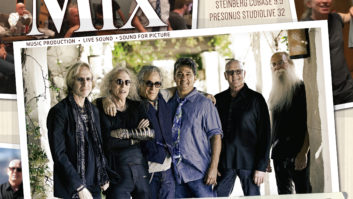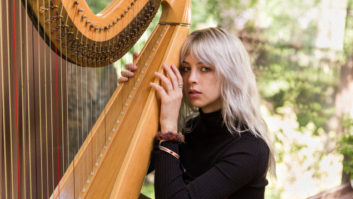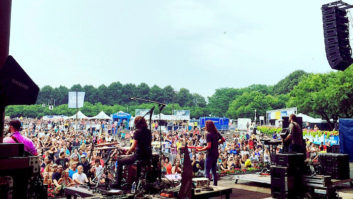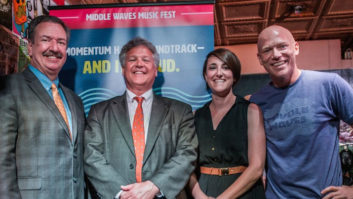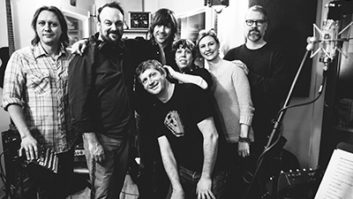Most bands—particularly those with a little something to prove—might schedule a tour so that they have a few shows under their belts before playing New York City. Not so with The Decemberists.

After its ambitious 2009 album, The Hazards of Love, arrived to a mixed reception, the Portland, OR-based group returned in January this year with The King Is Dead, a decidedly more concise collection of country- and folk-influenced indie rock. Rather than play a few shakedown shows before hitting the media capital of the world, the act kicked off its tour with no less than three sold-out shows at New York’s Beacon Theater, just as the album debuted at Number One on the Billboard chart. Given the glare of the spotlight, surely the band must have at least spent a lot of time in rehearsals.
“Three days,” laughed Rich Hipp, FOH engineer for the band. “With a half day of tech; yeah, it was run and gun.” Sitting relaxed in the orchestra seats with monitor engineer Marcel Cacdac hours before the final Beacon show, it was now clear that the rush to the stage hadn’t been detrimental; in fact, posted by the backstage door was the New York Post’s review of opening night, declaring “the group should be superstars.”
If that level of fame should come calling, The Decemberists will have to pack more production, as the tour is traveling light. With control gear and monitors supplied by Horne Audio—another Portland, OR entity—the production is picking up local PAs at each stop. For the Beacon Theater, that meant using the new in-house QSC-powered JBL VerTec system.
For the journey, Hipp and Cacdac are mixing on a pair of Avid Venue Profile consoles, used at both FOH and in monitorworld. “I don’t use that much automation, if any at all,” said Hipp. “I use a few snapshots and events, but I can live without it, because I mix as if it was an analog console. So far, nothing’s really that cuespecific; that may change going on, but I feel I should be able to make it happen between songs.”
The lack of automation is actually a change of pace for Hipp, who used to mix snapshot-heavy and then went in the opposite direction. “With this band, it’s pretty much all things happening at once—all the time! People jumping around to different positions and things, so I really just try to stay in the moment with the band and serve the music.”
The end result is a show sound that Hipp describes as “a pretty natural-sounding mix. There’s nothing that’s hyped or changed in any way from what they’re putting out there at the source.” Hipp tries to emulate the feel of the band’s albums as closely as possible, and despite the short rehearsal time, that was a relatively easy feat to accomplish, as he’s been the assistant studio engineer on the group’s last three discs: “Yeah, it makes it easy because the music’s already been pounded into my head.”
Up at stageside, Cacdac is mixing to a combination of personal monitor systems and a single wedge. He explained, “When they initially asked me to do monitors for the band, they were on wedges and I said, ‘Only if you switch to ears.’ They were willing to give it a shot, and it’s evolved quite a bit from the first time we took these out. We started very simply and it’s grown; at one point, it got to where I was mixing really heavily with a lot of cues. It wasn’t enough dynamics for him [Hipp] at front of house and he was having to chase around the mix consequently. Now it’s at a place where everyone has a very similar mix, the dynamics are for them to play within and I’m not mixing so much per song.”

These days, the band performs with nearly all members wearing Sensaphonics ProPhonic 2Xs in-ears running through Sennheiser 2000 series wireless. Meanwhile, stage left guitarist Chris Funk has switched back to a traditional monitor, hearing everything through an L-Acoustics 115XT HiQ.
The result is a moderately quiet stage, which benefits the miking, most of which consists of Audix microphones. “It’s not an endorsement thing,” Hipp explained.“I’ve pretty much used all the mics that are out there, and I don’t necessarily think that one is better than the other, but I thought, ‘These work great, and they’re made here in my town, so why not? They’re a Portland company, and I like to support the home team.”
On the kit, an Electro-Voice N/D868 captures the bass drum (“You can get any kind of kick drum sound you want out of it,” said Hipp) and a Shure VP88 stereo condenser is used for overheads, but the rest of the stage is comprised of Audixes, including the VX10 used for singer Colin Meloy and the OM6s that capture backing vocals. DIs on stage include an A-Designs RedDI on bass, Pendulum Audio SPS-1 acoustic preamp on Meloy’s acoustic instruments, and nearly a dozen Radial J48s throughout the rest of the stage.
A new addition to the mic collection is an Audix SCX1 instrument condenser mic used to capture vocals from drummer John Moen. “We’ve kind of surrendered to having bleed in the drum vocal,” said Cacdac, “and instead of fighting it, employing as much rejection as possible, Rich had the idea of ‘Why don’t we throw up a condenser?’ It’s been working out great because now the bleed that comes through basically sounds like another overhead.”
Hipp first got into sound while at college in the ’90s; he recalled “Some friends had a band, sound gear was around and I thought, ‘I’ll give that a shot,’ so I dabbled in it out of curiosity—and then it evolved from there into a weird, sick and twisted addiction!” The band in question was a regional act, Calobo, that included keyboardist Jenny Conlee and bassist Nate Query; the two would later co-found The Decemberists with Meloy in 2000. When not on the road with the act, Hipp has also worked with other indie rock stalwarts like Sufjan Stevens, M. Ward, Devandra Banhart and Neko Case, among others.
Cacdac, meanwhile, began working with the band in the mid-2000s, following years in the trenches with a variety of acts: “When I got started, I wanted to be a recording engineer—win Grammies, produce records and all of that. Then I moved to San Francisco and a friend working at a sound company got me a job almost immediately. I mean, I was there for maybe three days and had all these interviews set up at studios like Different Fur and Record Plant out in Sausalito—and I didn’t go to any of them! I just started working in the shop and mixing, and never looked back.” Since then, he’s worked with a range of acts, including Morrissey, B.B. King, Michael Franti and Spearhead, Secret Machines, The Breeders, Jerry Cantrell and Cake.
These days, however, The Decemberists are the engineers’ focus and will be until the band’s multi-leg tour wraps up sometime in September. While the theater tour will take them running through Europe with support from Eighth Day Sound, the high point for Hipp will be when they start hitting festival season: “Mixing a festival definitely requires a different approach, but it’s nice and not like we’re jumping up to a hockey arena, which would be a big change. Everybody loves mixing outside, right?”
Horne Audio
horne-audio.com
Avid
Avid.com
Audix
audixusa.com
VITAL STATS
The Decemberists
Horne Audio (Portland, OR)
FOH Engineer:
Rich Hipp
Monitor Engineer:
Marcel Cacdac
FOH Console:
Avid Venue Profile
Monitor Console:
Avid Venue Profile
Monitor Speakers:
L-Acoustics 115XT HiQ
Personal Monitors:
Sennheiser 2000 series wireless; Sensaphonics ProPhonic 2Xs in-ears
FOH Equipment/Plug-Ins:
Standard onboard package
Monitor Equipment/Plug-Ins:
Standard onboard package
Microphones:
Audix SCX1, OM6, VX10; Electro-Voice N/D868; Shure VP88; A-Designs RedDI; Pendulum Audio SPS-1; (12) Radial J48

